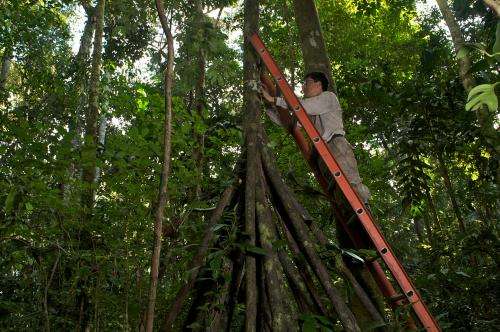Direct evidence that drought-weakened Amazonian forests 'inhale less carbon'

For the first time, an international research team has provided direct evidence of the rate at which individual trees in the Amazonian basin 'inhale' carbon from the atmosphere during a severe drought. They measured the growth and photosynthesis rates of trees at 13 rainforest plots across Brazil, Peru and Bolivia, comparing plots that were affected by the strong drought of 2010 with unaffected plots. They found that while growth rates of the trees in drought-affected plots were unchanged, the rate of photosynthesis - by which trees convert carbon into energy to fuel their activities - slowed down by around 10 percent over six months. Their paper, published in the journal, Nature, concludes that trees may be channelling their more limited energy reserves into growth rather than maintaining their own health. Computer simulations of the biosphere have predicted such responses to drought, but these are the first direct observations of this effect across tropical forests.
The three-year international study is the first detailed, large-scale examination of the complete carbon cycle, looking at both the growth and metabolism of forest plots at different sites across the Amazon basin. Each of the plots is one hectare and contains around 400-500 trees. The rainforest plots chosen were representative of the varying climatic and soil conditions of the Amazon basin. The study is the product of a new effort, co-ordinated by Oxford University, to closely track the functioning of tropical forests across the world: the Global Ecosystems Monitoring network (GEM).
The findings are the result of a huge and challenging field effort: over a three-year period, local students and technicians spent several weeks every month at each site to measure each tree's woody growth rate and the number of small roots that had grown. Researchers weighed monthly leaf fall, using nets, to establish the number of leaves each tree was producing. They also used infra-red gas analysers to track the release of carbon dioxide from living wood, roots, and leaves to estimate the metabolic activity of the forest. By chance, the Amazon drought of 2010 occurred right in the middle of this observation window, but only affected some parts of Amazonia.
Researchers found that while the rate of photosynthesis was constant among trees on plots unaffected by drought, rates on the six drought-affected plots dropped significantly (as compared with before the 2010 drought). They also discovered that while the growth rates of drought-affected plots were unchanged, levels of tissue maintenance and the general health of trees were reduced. The paper reasons that growth rates of drought-affected trees did not change, despite their limited energy supplies, because otherwise they would be at a disadvantage when competing for light, water or nutrients. But it adds that this neglect of maintenance came at a cost, and is likely to have led to the increase (up to a trebling in some sites) in numbers of trees dying in the years after the drought.
Study lead author Dr Christopher Doughty, from the Environmental Change Institute in School of Geography and the Environment at the University of Oxford, said: 'Tropical rainforests have been popularly thought of as the "lungs" of the planet. Here, we show for the first time that during severe drought, the rate at which they "inhale" carbon through photosynthesis can decrease. This decreased uptake of carbon does not decrease growth rates but does mean an increase in tree deaths. As trees die and decompose, the concentrations of carbon dioxide in the atmosphere will increase, potentially speeding up climate change during tropical droughts.'
These results support the findings of an earlier paper in Nature, published last year, based on aircraft data. Taken together, the research data provides a picture, from the leaf scale to the global scale, suggesting that droughts in the Amazon basin are affecting levels of carbon dioxide in the atmosphere globally, both on a short-term basis though decreasing photosynthesis and on a longer term basis, by increasing tree mortality.
The GEM network plans to continue to closely monitor tropical forests in the Americas, Africa and Asia over the coming decades, to understand how these forests are affected by changing climate.
'These plots are our canaries in the climate change coal mine,'said co-author and GEM co-ordinator Professor Yadvinder Malhi, also from the Environmental Change Institute in the School of Geography and the Environment. 'As this study demonstrates, they can give us important early insight into the actual mechanisms of how these complex forests are responding to extreme climates. Only through painstaking monitoring, like this, can we hope to understand and realistically model and predict the two-way interactions between climate change and the biosphere.'
More information: The paper, 'Drought impact on forest carbon dynamics and fluxes in Amazonia', is due to be published by Nature on 5 March 2015. DOI: 10.1038/nature14213
Journal information: Nature
Provided by Oxford University




















